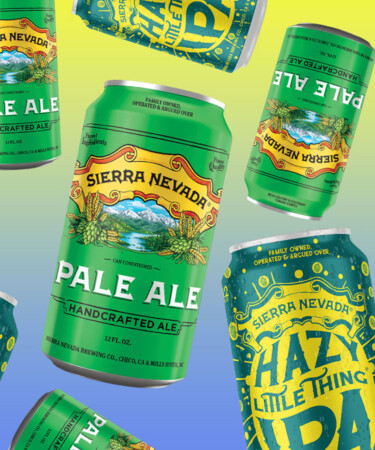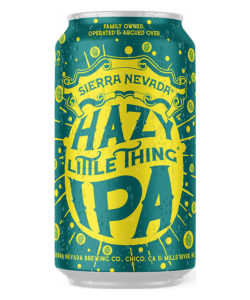Now a household name among beer drinkers and beloved for its iconic New England IPA Hazy Little Thing, Sierra Nevada Brewing was once, believe it or not, a one-man operation. Founder Ken Grossman purchased his first homebrewing kit in 1969 before discovering California’s Sierra Nevada mountains a year later. In 1980, the Sierra Nevada Brewing Co. was born. Today, it’s one of the largest craft breweries in the United States.
A pioneer in ultra-hoppy ales, sustainable brewing practices, and brewing machinery, the company has continually innovated to repeatedly attract new drinkers. Now that you know the basics, here are 10 more things you should know about Sierra Nevada Brewing.
Sierra Nevada is canned American ingenuity.
When Grossman founded the brand in the early ‘80s, small-scale brewing equipment wasn’t exactly easy to come by. So, Grossman did what many craft brewers would do over the course of the next few decades: He retrofitted unused dairy equipment to make a functioning brewhouse. It was these recycled parts and machinery that were used to brew the first batch of Sierra Nevada’s flagship Pale Ale, the very same beer that rocketed them to public success Now, the brewing company produces over 1 million barrels of beer per year at its two locations.
Ken Grossman is something of a hops pioneer.
In 1976, two years before homebrewing was legalized, Grossman opened up a homebrewing store, The Home Brew Shop. There, he sold various brewing paraphernalia and taught classes to other novices. Just one year later, he revolutionized the use of hops in brewing by driving straight to the Yakima Valley and persuading suppliers to sell him hundreds of hop samples that he then sold in his homebrewing shop. Come 1980, just two years after the legalization of homebrewing, Grossman was finally able to brew his revolutionary pale ale — one of the nation’s first hop-forward yet shelf-stable beers. Three years later, he innovated again with the release of Bigfoot, one of the first American barleywines, and a decade later, the brewery debuted the nation’s very first “wet hop” harvest ale. In 2009, Sierra Nevada unveiled what would become the envy of his peers and, later, a brewery staple: the Hop Torpedo. The hop delivery system employs a mechanism that enables brewers to amplify aromas when dry-hopping with whole-cone hops, thus transforming the flavors of the resulting beers. This mechanism is the namesake of the brewery’s beloved Torpedo IPA.
Grossman upped his equipment after a trip to Germany in the ‘80s.
Shortly after nailing the recipe for his flagship beer, Sierra Nevada’s popularity took off, and Grossman found himself unable to fulfill demand for the hoppy Pale Ale with the equipment he had at his disposal. That’s why in 1983, he sought out a higher-quality, copper brewhouse. The only problem? The brewhouse in question was all the way in Germany. So, Grossman embarked across the Atlantic in pursuit of the handmade kettle, which he then disassembled and shipped back to California. Unfortunately, thanks to the immense cost of transporting the brewhouse, the kettle had to sit in storage for four years when there was enough money — and a permanent home — to make use of it..
Every year is a celebration in the mountains.
In 1981, Sierra Nevada debuted its still-popular Celebration Ale, which is widely considered to be one of the first American IPAs. The ale is also believed to be one of the first beers brewed specifically for the holiday season. However, unlike most traditional winter beers that are typically spiced and fall on the sweet side, Sierra Nevada utilized fresh hops gathered from the year’s harvest to impart floral and bitter flavors on its own ale.
‘Malt Disney’ is actually a real place.
Sierra Nevada has been operating out of its 20th Street location in Chico, Calif., since 1987, but upon maxing out capacity in 2010, an expansion was necessary. In 2014, the brewery expanded to the East Coast with the opening of its production facility in Mills River, N.C. Keeping true to family tradition, Brian Grossman, Ken’s son, took on the management of the new brewery. Just one year later, the Mills River location unveiled its taproom and restaurant. According to the company’s history, locals and visitors “lovingly” refer to the state-of-the-art brewery campus as “Malt Disney.”
Hops are of the utmost importance in every beer brewed at Sierra Nevada.
Sierra Nevada rolls out more than a dozen year-round releases, five of which are now included in the company’s staple “Little Thing” lineup. Additionally, the brewery produces four seasonal brews per year — Powder Day IPA, Summerfest, Oktoberfest, and Celebration IPA — as well as four limited-edition rotating “high altitude beers,” — a collection of high-ABV brews. Most recently, the brewery has entered the non-alcoholic category with the launch of its Hop Water, and has even ventured into the world of fermented drinks with its line of canned cocktails.
The brewery’s pale ale has inspired some of the country’s best brewers.
After a trial run of brewing stouts, the brewery became famous for its first release, the hop-forward Sierra Nevada Pale Ale. Made using Cascade hops, the Pale Ale imparted new flavors on a traditional beer that inspired a host of brewers to try the same. Industry figures like Founders Brewing brewmaster Jeremy Kosmicki, Cloudburst Brewing founder and head brewer Steve Luke, and Fremont Brewing co-founder and co-owner Sara Nelson all cite Sierra Nevada Pale Ale as inspiration.
Sierra Nevada’s sustainability efforts have other brewers green with envy.
According to the brand, “reduce, reuse, recycle” is more than just a catchy phrase — it’s an integral part of its business model. The brewery began its carbon footprint-erasing path to clean energy in 2004 when it installed four hydrogen fuel cells at its Chico brewery, which are used to generate clean electricity. Three years later, the company implemented the use of solar panels to generate more electricity. Today, nearly 11,000 solar panels have been installed and generate enough electricity to power 20 percent of the brewery’s operations. With its Mill River offshoot, which has approximately 2,200 solar panels, Sierra Nevada maintains the U.S.’s largest private solar array. Perhaps one of the brewery’s highest honors was bestowed in 2016, when the Mill River location became the very first brewery in the nation to be awarded with Leadership in Energy and Environmental Design (LEED) Platinum Certification — the world’s most prestigious green-building rating system.
The brewery camps — and parties — across America.
In 2014, Sierra Nevada launched the traveling beer festival Beer Camp Across America, and it was pretty epic. The festival began in California and ended in North Carolina, and invited each and every brewery in the United States to participate. In total, more than 700 breweries showed up to pour beer at Beer Camp. In celebration, Sierra Nevada created a mixed 12-pack that included beers brewed in collaboration with a dozen American breweries. While Beer Camp is stationary today — held annually in Sierra Nevada’s Hop Field in Chico — the festivities aren’t any less jubilant. At the most recent Beer Camp, in early May, patrons could participate in a number of classic camp activities like rope obstacle courses and rock climbing walls, as well as more adult games like keg bowling.
Sierra Nevada holds a world record.
In March 2021, to celebrate the release of its new Imperial IPA, the brewery constructed a bright purple, 20-foot tall catapult it named The Big Little Thing Catapult and loaded it up with a 120-pound keg of the beer. The keg ended up soaring an impressive 438.81 feet, breaking the Guinness World Records title for the farthest distance a trebuchet has thrown a projectile weighing at least 44 pounds, obliterating the previous record of 253 feet.

